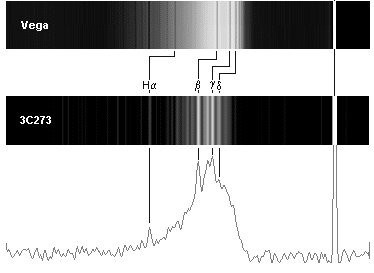 Go to the BAA Journal home page
Go to the BAA Journal home page
J. Brit. Astron. Assoc., 109, 1, 1999, p.8

This emission line spectrum of the quasar 3C273 in Virgo is compared to the hydrogen absorption lines in the nearby star Vega which is used as a 'static' reference. Each spectrogram also contains the direct undispersed stellar image (zero order spectrum) of Vega and 3C273 respectively, as points of light to the right and these are used to align the two spectrograms. The quasar shows a line shift redwards (z) averaging 0.16 or ~16% of the velocity of light, i.e. a recession of ~48,000km/sec - close to professional figures. Note that the quasar spectrum is not simply shifted bodily sideways but is progressively expanded more towards the red end - the H-alpha line is 'moved' noticeably more than H-beta and so on. Allowing for the varying Hubble Constant (!) 3C273 is assumed ~3billion light years away. This spectrum may be an amateur first to show a cosmological redshift.
3C273 image taken 1998 Dec 21 with 30cm SCT + spectroscope (dispersion 160nm/mm) + Starlight Xpress MX9 CCD camera; 24m exposure (integration of 6 exposures). Vega exposure 10s. © 1998. Maurice Gavin, Worcester Park Observatory, Surrey, England.
 Go to the BAA Journal home page
Go to the BAA Journal home page
Return to Journal 1999 February contents page